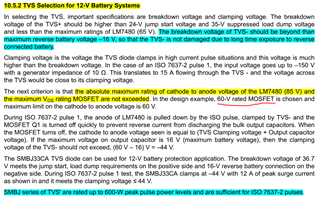Tool/software:
Hi everyone,
I have a doubt regarding some calculations within the LM7480-Q1 datasheet (in section 10.5.2: TVS Selection for 12V Battery Systems).
In order to select a proper TVS diode to clamp the negative voltage pulses, "the maximum clamping voltage of the TVS diode should not exceed -44V" for that specific use case (a 12V-battery system). However, the SMBJ33CA TVS diode is proposed, whose breakdown voltage is correctly written in the LM7400-Q1 datasheet (36.7V), but the clamping voltage is much higher (53.3V at Ipp = 11.3A). In automotive, the ISO pulses could be -600V, so I assume the currents are quite high (600V / 50Ohm impedance = 12A) during a very short pulse (~1ms). When that much current flows through the TVS diode, the voltage level will be clamped to 53.3V, not 36.7V, is that right? In that case, the instantaneous drain-source voltage applied to said MOSFET would be (16V + 53.3V ~ 70V), which would break the 60V-rated MOSFET recommended in the datasheet. Are the TVS diodes slower than the 1ms ISO pulses? Am I assuming anything wrongly? Could you elaborate on the calculations?
Thank you for your time and I'm looking forward to your reply!
Best regards,
Juan




